- STATISTICAL RELEASE
Euro area quarterly balance of payments and international investment position: second quarter of 2020
2 October 2020
- Current account surplus at €252 billion (2.2% of euro area GDP) in four quarters to second quarter of 2020, down from €261 billion a year earlier
- Geographic counterparts: largest bilateral surpluses vis-à-vis United Kingdom (€149 billion) and United States (€92 billion), with largest deficits vis-à-vis offshore centres (€98 billion) and China (€78 billion)
- International investment position showed net liabilities of €12 billion (around 0.1% of euro area GDP) at end of second quarter
Current account
The current account surplus of the euro area declined to €252 billion (2.2% of euro area GDP) in the four quarters to the second quarter of 2020, from €261 billion a year earlier (see Table 1). This decrease reflected a reduction in the surpluses for services (from €69 billion to €36 billion) and primary income (from €73 billion to €52 billion). These developments were partly offset by an increase in the surplus for goods (from €280 billion to €317 billion) and a lower deficit for secondary income (down from €161 billion to €152 billion).
The smaller surplus for services was mainly due to an increase in the deficit for other business services (from €79 billion to €96 billion) and a decline in the surplus for travel (from €40 billion to €25 billion). These developments were only partially offset by an increase in the surplus for telecommunication, computer and information services (from €84 billion to €98 billion).
The decrease in the primary income surplus was due to a fall in the surplus for investment income (from €46 billion to €22 billion). This reflected a lower surplus for direct investment income (down from €108 billion to €54 billion), which was partly offset by a smaller deficit for portfolio equity income (down from €102 billion to €83 billion) and a larger surplus for portfolio debt income (up from €27 billion to €36 billion).
Table 1
Current account of the euro area
(EUR billions, unless otherwise indicated; transactions during the period; non-working day and non-seasonally adjusted)
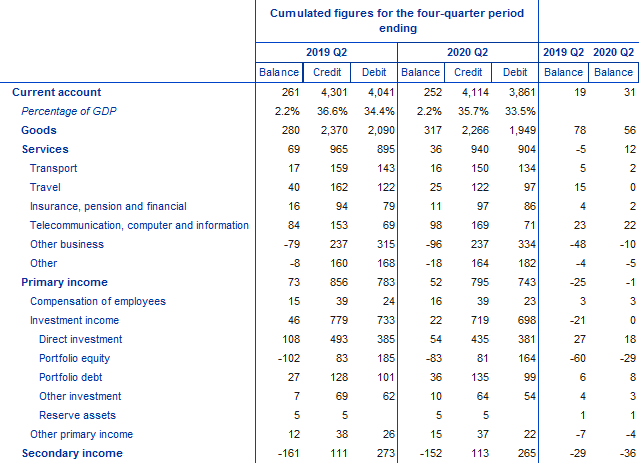
Source: ECB.
Notes: “Equity” comprises equity and investment fund shares. Discrepancies between totals and their components may arise from rounding.
Data on the geographic counterparts of the euro area current account (see Chart 1) show that in the four quarters to the second quarter of 2020 the euro area recorded its largest bilateral surpluses vis-à-vis the United Kingdom (€149 billion, down from €179 billion a year earlier), the United States (€92 billion, down from €107 billion) and Switzerland (€55 billion, down from €57 billion). It also recorded a current account surplus vis-à-vis a residual group of other countries (€161 billion, up from €98 billion). The largest bilateral deficits were recorded vis-à-vis offshore centres (€98 billion, up from €72 billion) and China (€78 billion, up from €63 billion).
The most significant geographic changes in the four quarters to the second quarter of 2020 relative to the previous year were as follows. In the goods balance there was an increase in the deficit vis-à-vis China (from €77 billion to €93 billion), a decrease in the surplus vis-à-vis the United Kingdom (from €110 billion to €97 billion) and a shift from a deficit of €25 billion to a surplus of €49 billion vis-à-vis the residual group of other countries, reflecting partly a decline in the deficit vis-à-vis Russia (from €45 billion to €17 billion). In services, increased deficits vis-à-vis the United States (up from €14 billion to €40 billion) and offshore centres (up from €81 billion to €96 billion) were recorded. Moreover, the primary income surplus vis-à-vis the United Kingdom decreased from €21 billion to €11 billion, while the secondary income deficit vis-à-vis the EU Member States and EU institutions outside the euro area declined from €101 billion to €89 billion.
Chart 1
Geographical breakdown of the euro area current account balance
(four-quarter moving sums in EUR billions; non-seasonally adjusted)
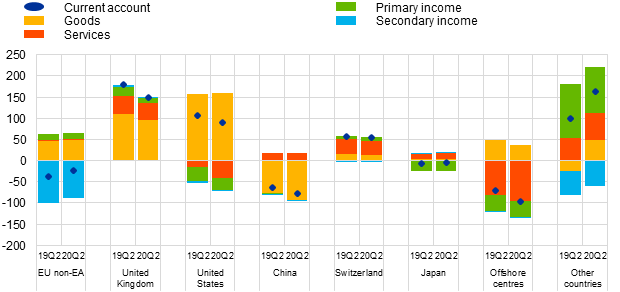
Source: ECB.
Note: “EU non-EA” comprises EU Member States and EU institutions outside the euro area. “Other countries” includes all countries and country groups not shown in the chart, as well as unallocated transactions.
International investment position
At the end of the second quarter of 2020 the international investment position of the euro area recorded net liabilities of €12 billion vis-à-vis the rest of the world (0.1% of euro area GDP), compared with net liabilities of €33 billion in the previous quarter (see Chart 2 and Table 2).
Chart 2
Net international investment position of the euro area
(net amounts outstanding at the end of the period as a percentage of four-quarter moving sums of GDP)
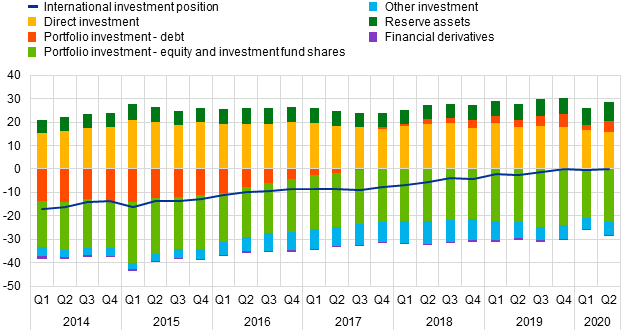
Source: ECB.
This improvement of €21 billion reflected large but partly offsetting changes in the various investment components. Larger net assets were recorded for portfolio debt (€554 billion, up from €252 billion), while for direct investment net assets declined, to €1,828 billion (from €1,963 billion). Larger net liabilities were recorded for portfolio equity (€2,629 billion, up from €2,516 billion) and for other investment (€637 billion, up from €533 billion).
Table 2
International investment position of the euro area
(EUR billions, unless otherwise indicated; amounts outstanding at the end of the period, flows during the period; non-working day and non-seasonally adjusted)
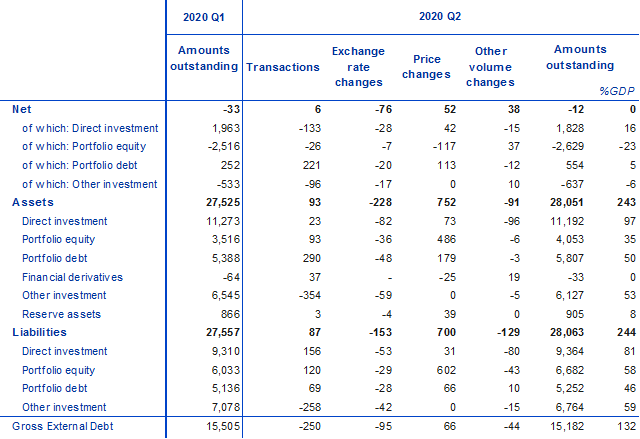
Source: ECB.
Notes: “Equity” comprises equity and investment fund shares. Net financial derivatives are reported under assets. Discrepancies between totals and their components may arise from rounding.
The change in the euro area’s net international investment position in the second quarter of 2020 was driven by positive net price changes, other volume changes and transactions, which were only partially compensated by negative net exchange rate changes (see Chart 3).
The increase in net assets for portfolio debt was due to transactions and positive net price changes (see Table 2), while lower net assets for direct investment resulted mainly from negative transactions. The increase in net liabilities for portfolio equity stemmed largely from negative net price changes, as the effect of the rise in equity prices was larger for liabilities than for assets. Larger net liabilities for other investment were mainly driven by transactions.
At the end of the second quarter of 2020 the gross external debt of the euro area amounted to €15.2 trillion (around 132% of euro area GDP), down by €323 billion compared with the previous quarter.
Chart 3
Changes in the net international investment position of the euro area
(EUR billions; flows during the period)
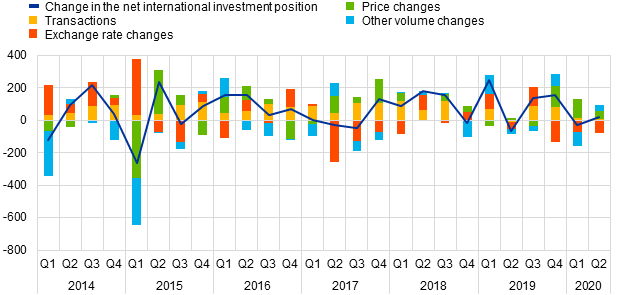
Source: ECB.
Note: “Other volume changes” mainly reflect reclassifications and data enhancements.
Data revisions
This statistical release incorporates revisions to data for the reference periods between the first quarter of 2016 and the first quarter of 2020. The revisions reflect revised national contributions to the euro area aggregates as a result of the incorporation of newly available information.
The production of balance of payments and international investment position statistics has in most countries been affected by the coronavirus (COVID-19) crisis. The impact of the crisis across the euro area has created challenges for the data collection and compilation process. In addition, the abrupt economic impact of measures to combat the crisis has caused particular difficulties for the estimation of infra-annual data, and these releases are therefore subject to higher uncertainty. More information on the potential impact of the COVID-19 crisis on balance of payments and international investment position statistics can be found here.
Next releases
- Monthly balance of payments: 20 October 2020 (reference data up to August 2020)
- Quarterly balance of payments and international investment position: 11 January 2021 (reference data up to the third quarter of 2020)[1]
For queries, please use the Statistical information request form.
Notes
- All data are neither seasonally nor working day-adjusted. Ratios to GDP (including in the charts) refer to four-quarter sums of non-seasonally and non-working day-adjusted GDP figures.
- Hyperlinks in this press release lead to data that may change with subsequent releases as a result of revisions.
- On 29 October 2020 there will be a second release of the quarterly balance of payments and international investment position data (reference data up to the second quarter of 2020) with revisions to data for periods since the first quarter of 2013. This second release will not include a press or statistical release and is aimed at ensuring consistency between the balance of payments/international investment position and the euro area sector accounts.


